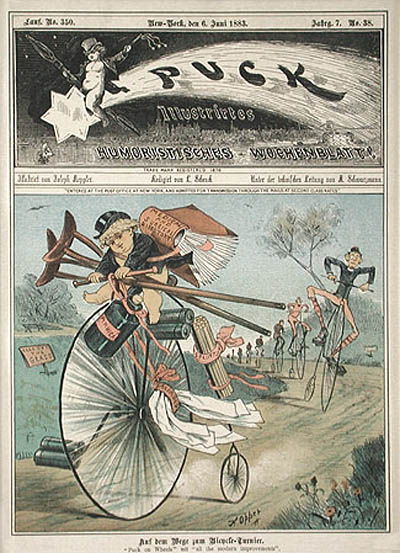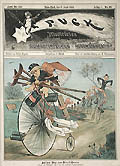| Title: |
Puck on Wheels with All The Modern Improvements (Puck, New York) |
| Artist: |
Opper, Frederick Burr (Madison, Ohio, 1857 - New York, 1937) |
| Date: |
1883 |
| Medium: |
Original Lithograph Printed in Colors |
| Publisher: |
Puck, New York |
| Printer: |
Puck, New York |
| Note: |
Frederick Burr Opper: The Son of an Austrian immigrant to the American Midwest, Frederick Opper embarked upon his artistic career at the tender age of fourteen. He joined the staff of Puck in the late 1870's and remained as on of its leading artists for the following eighteen years. He later became on of the originators of the American comic strip, beginning in 1889 with his work for William Randolph Hearst's New York Evening Journal. 'John Q. Public' and 'Willie and his Papa' were but two of his many inventions. Frederick Burr Opper also worked for Frank Leslie's Publishing House (1877-1880). |
| |
As a satirical artist, Frederick Burr Opper has often been compared to Thomas Nast. Like Nast, his images could range from light humour to strong indictment. Frederick Opper retired from active work in 1932 due to failing eyesight. Opper's original lithograph entitled, Puck on Wheels with All The Modern Improvements is
a hilarious commentary of the dangers involved in the initial years of
cycling. and portrays this fact in typical 'Puck' style. It is
a perfect example of the satire and humour used to depict its victims
. |
| |
Puck and The Comic Lithograph: The history of Puck begins with an Austrian caricaturist, who was to become one of the most influential satirical artists and editors of nineteenth century America, Joseph Ferdinand Keppler (1838 - 1894). Joseph Keppler moved to the United States in 1868 and In 1871 he and his partner, Adolph Schwarzmann (1838-1904) first established Puck Magazine in St. Louis. The magazine did not fare well and folded within a year (1872). Soon after, Keppler began working for Frank Leslie’s Illustrated Newspaper and within four years he had become a leading artist in that firm. Not satisfied with his position, Keppler left Frank Leslie’s Illustrated Newspaper in 1876 and decided to started out on his own again. During that year, Keppler and Schwarzmann went to New York and began to publish their Puck Magazine again, this time, with great success, Keppler had finally become the editor and leading artist of his own creation, Puck. This periodical holds an important place in the history of American satire. It was initially meant to be America’s answer to England’s Punch, but under Keppler’s astute editorship it began to emphasize artworks, particularly its large original color lithographs, on a much more ambitious and accomplished scale than its English rival. * "By this time Joseph Keppler had generated a style and approach to caricature that was to dominate American Humour for years to come. "Like Punch, Puck had its own mascot, the wonderful little character who appears in this original lithograph is depicted in the foreground. He is the one leading in this high wheel bicycle race. "Puck on Wheels with all the Modern Improvements" was designed by Frederick Burr Opper for Puck Magazine in 1883. It is a striking example of the artistic works created for this firm. |
| |
The New York Puck Magazine was first issued in German to appeal to America’s large German speaking population. That issue was printed on the presses of the lithographic firm of Mayer, Merkel and Ottmann located at 22 & 24 Church St., between Barclay & Versey Streets, New York. Puck became such a huge success that it later published issues in English. Joseph Keppler also managed to attract some of the greatest satirical artists of the time to Puck, including Frederick Graetz, Bernhard Gillam, Frederick Opper and A. B. Frost. Around 1885, Puck's lithographic printer, Jacob Ottmann renamed his firm as J. Ottmann Lithographing Company. And, that same year Ottmann and the publishers of Puck magazine, Joseph Keppler & Adolph Schwarzmann commissioned the architect Albert Wagner to design and erect a new building for their firms. By 1886, it was completed and they moved into what is now known as the Puck building, located at Houston Street, in Manhattan. The famous golden Puck mascot that was placed on the front of the 'Puck Building' when it was constructed can still be seen on this historical building today. Puck on Wheels with All The Modern Improvements was printed and published before they moved to this address. At Keppler's death, the editorship passed to his son, Joseph Keppler, Jr., 'nee Udo Keppler' (1872-1956), who continued to commission fine satirical artists into the initial years of our century. |
| Reference: |
* William Feaver, Masters of Caricature, Weidenfeld
and Nicolson, London, 1981, p. 96. |
| Size: |
12 1/4 X 8 3/4 (Sizes in inches are approximate,
height preceding width of plate-mark or image.) |
| |
Matted with 100% Archival Materials |
| |
View larger Matted Image |
| |
 |
| Buy Now |
Price: $175.00 US |
| Condition: |
Printed on nineteenth century wove paper and with full margins
as published by Puck. This is a strong impression and in excellent condition
throughout. Altogether, Puck on Wheels with All The Modern Improvements
is a fine example of the original graphic work of this famous periodical. |
| Important Information: |
The artist biographies, research and or information pertaining to all the original works of art posted on our pages has been written and designed by Greg & Connie Peters exclusively for our site, (www.artoftheprint.com). Please visit us regularly to view the latest artworks offered for sale. We will soon be posting an update of our most recent research and include the biographical and historical information pertaining to our next collection of original works of art created by artists throughout the centuries. We hope you found the information you were looking for and that it has been beneficial.
Our Gallery, (Art of the Print / www.artoftheprint.com) guarantees the authenticity of every work of art we sell 100%. Full documentation and certification is provided. We offer a wide selection of international fine art dating from the early Renaissance to the contemporary art period. |













![]()
![]() or
phone Greg & Connie (905) 957-6666
or
phone Greg & Connie (905) 957-6666